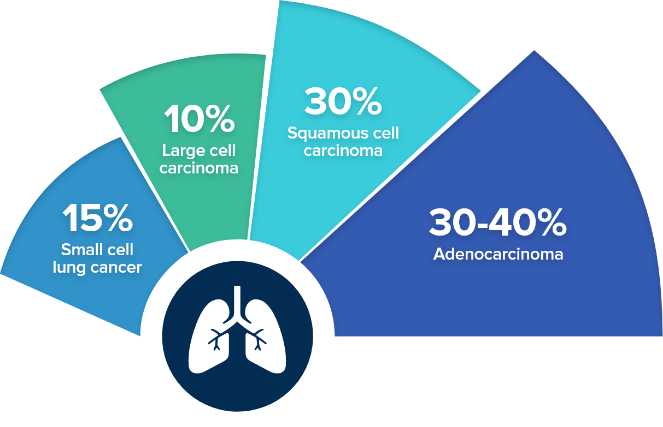When abnormal cells multiply and become out of control, they can lead to cancer. This occurs when the original tissues are transformed into a tumour. The danger of this disease is that it can invade other tissues, leading to damage.
When a tumour spreads to other parts of the body, it is referred to as metastasis. This occurs when cancer spreads to other organs and tissues through the bloodstream or lymphatic system. When a cancer which originates in the lung spreads to other parts of the body, it is referred to as a primary tumour. On the other hand, the growth of cancer in the other body part is referred to as a secondary (metastatic) tumour.

The survival rate of patients with this disease depends on the stage of disease and is highest for early stage (I and II) lung cancer, which is best treated with surgery in combination with other treatments such as targeted therapy or immunotherapy.
These are further subdivided into a few types:
• Adenocarcinoma (30-40%)
• Squamous cell carcinoma (30%)
• Large cell carcinoma (10%)
This type of cancer is less common. The cancer cells can grow rapidly and most of the time, the cancer has spread early to other parts of the body.
Other types of cancer found in the lungs are carcinoid, large cell neuroendocrine carcinoma and lymphoma (5%).
Most lung cancer cases are caused by tobacco smoke. This includes both second-hand and active smoking. Over 4,000 chemical substances are known to be involved in developing lung cancer. Smoking 20 cigarettes daily doubles a person's chances of getting this disease.
Smoking cessation reduces the risk of getting lung cancer. Fifteen years after a smoker stops smoking, their chances of getting the disease are similar to that of non-smokers.
Cigar and pipe smoking also increase the risk of developing lung cancer.

Asbestos exposure can increase a person's chances of getting lung cancer several times. The interaction between asbestos and tobacco smoke can also increase a person's risk of getting this disease by about 50 times.
Tuberculosis and chronic obstructive pulmonary disease are other conditions that can increase the risk of developing lung cancer. People exposed to various chemicals, such as chromium, nickel, cobalt, arsenic, and aromatic hydrocarbons, are also at risk.
Air pollution from vehicles, factories and others can increase the risk too.
A family history of the disease (genetics)
Different factors can cause lung cancer. If you are one of the individuals who are at risk of developing lung cancer, then you may have symptoms such as difficulty breathing, or you may be asymptomatic.
One of the most common symptoms of lung cancer is coughing. It is known that smokers often experience chronic coughs. However, a change in the intensity or nature of their cough is also a vital sign.
The other symptoms of lung cancer include fatigue, shortness of breath, and pain in the chest and shoulder. It can also cause a person to lose weight and appetite. In addition, the disease can cause a person to have recurrent chest infections.

Targeted blood tests are performed to help determine treatment options.

You will be asked to cough deeply and spit any phlegm that comes up from your lungs into a special container.

It is not always a sign of lung cancer. It can sometimes show a lung mass (opacity), a lung infection or build-up of fluid in the chest cavity.

It is a type of medical test that can quickly visualise with great detail and precision the entire lung. It can also determine the size and location of the cancer and its spread to other organs.

It is a medical procedure that uses a flexible tube and a video camera to visualise the airways inside the lungs. A biopsy is performed to confirm the diagnosis if a doctor discovers an abnormality.

a diagnostic and staging scope done by some gastroenterologists to sample (biopsy) suspicious lymph nodes in the centre of the chest (mediastinum).

A pleuroscope is used during this procedure to visualise the inner portion of the chest cavity. It can be done to check for signs of cancer or if there is a build-up of fluid or thickening of the chest wall lining (pleura) . A biopsy is then performed to confirm the type of cancer.

Commonly used to detect the presence of cancer and determine extent of spread to other organs (staging).

A mediastinoscopy is a procedure sometimes used to sample swollen lymph nodes in the centre of the chest cavity in patients with suspected or confirmed lung cancer, if an EUS is not possible or inconclusive.
Treatment of lung cancer depends primarily on the following:
SJMC and its Cancer & Radiosurgery Centre have been recognised for leadership in cancer management, providing the best possible care for patients. Equipped with the latest technology (eg. state-of-the-art LDCT and PET scans, NGS testing ) and staffed by a multi-disciplinary team of highly trained board-certified medical specialists, SJMC is truly one of the few one-stop centres for lung cancer care from screening, diagnosis, staging to treatment; both curative and palliative.
The staff members and doctors at our centre are dedicated to providing the best possible personalised care for each patient. They aim to enhance the patient's emotional and physical well-being, whether seeking preventive services or coping with therapy. The facility also offers various support groups and other services to help ease the daily stress of living with cancer.
